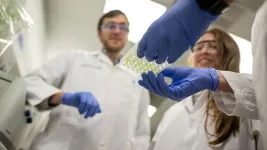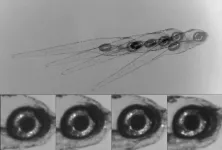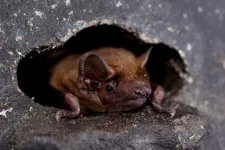(Press-News.org) MIAMI, FLORIDA (Jan. 2, 2025) – Many people are surprised by the intensity of their response when a well-known person dies, and their feelings of sadness may last longer than they expect. In fact, that sadness and grief can be intense, and preliminary research suggests that grief after the death of a public figure looks very similar to grief over our personal relationships and can have comparable levels of intensity.
Wendy Lichtenthal, Ph.D., a bereavement science researcher, is available to discuss “parasocial grief” – that which occurs when a celebrity, political figure or other highly recognized person dies.
In her research, Lichtenthal, founding director of the Center for the Advancement of Bereavement Care at Sylvester Comprehensive Cancer Center, part of the University of Miami Miller School of Medicine, focuses on advancing bereavement science and “meaning-centered” grief therapy for families, caregivers and others.
Here, she provides an overview of why we may grieve the loss of someone who has been in the news but not in our personal lives.
Lichtenthal: Bereavement theorists and scientists refer to the experience of grief following the death of a public figure as parasocial grief. Parasocial relationships can be thought of as one-sided, involving feeling a sense of connection to a public figure who one does not personally know. But parasocial relationships are, indeed, relationships, and it is natural to grieve when someone we care about and feel attached to dies.
Why is it natural to grieve relationships? Research within the fields of psychology and neuroscience suggests that we are “wired” to connect and attach to others. Our survival depends on it. From the time we’re born, we attach to our primary caregiver, and we protest separation. This is at the heart of grief: We do not want to be separated from people we feel attached to, and grief is a protest reaction.
A parasocial relationship does not represent the same kind of attachment that exists with a person we live with day to day, but it is a relationship. We grieve the loss of whatever was received “through” that relationship. Research suggests that public figures can embody our hopes for the future, act as reminders of the past, or symbolize important aspects of our worldview.
Political figures might offer a sense of hope, safety, or security. In the case of an entertainer, we might feel a sense of connection to their creative offerings. And maybe that public figure has been providing us with something in the here and now, or maybe they offered something in the past, sparking memories, thoughts and feelings connected to a certain time or era in our lives.
Some people may seem to be affected more intensely than others when a famous person dies. It comes back to the nature of the relationship. If someone felt especially connected to and close to that public figure, then it is natural to grieve. Research suggests that the degree of perceived closeness to the public figure is associated with the intensity of the grief that is experienced after their death.
One thing to keep in mind is that one’s experience of grief always makes sense. It may feel more intense than we expected because we weren’t as conscious of the layers of meaning that a given loss has or the special role a person or relationship played in our lives. But if I asked a grieving person more in-depth questions about who this person was to them, we would eventually find that their grief makes sense.
Also, there is no prescribed timeframe for grief – no amount of time someone “should” grieve. When we feel hurt, pain, or sadness, it’s natural to say, “How long might I endure this? What is typical or ‘normal’?” But the grieving process involves processing the reality that the person who died is no longer physically present in the world and adapting to that reality over time. Reminders of that reality can bring with them waves of pain at any time for the rest of our lives. Grief does not have a stop date.
To a person going through the process of grieving, we would say, “Rather than setting a timeline, give yourself space to reflect on the fact that this person somehow mattered to you, maybe more than you realized, and that’s OK.”
about this important work on the InventUM Blog and follow @SylvesterCancer on X for the latest news on its research and care.
# # #
END
A groundbreaking method for bridge construction is set to enhance performance, reduce construction time, and cut costs for future bridges across Texas.
Dr. Kinsey Skillen, assistant professor in the Civil and Environmental Engineering Department at Texas A&M University, was named Principal Investigator (PI) of the Texas Department of Transportation (TxDOT) research project titled “Develop/Refine Design Provisions for Headed and Hooked Reinforcement.”
The 42-month project, which received nearly $1 million in funding, is a joint effort between the Texas Transportation Institute and the University of Texas at San Antonio (UTSA) exploring more efficient methods ...
To stay healthy, plants balance the energy they put into growing with the amount they use to defend against harmful bacteria. The mechanisms behind this equilibrium have largely remained mysterious.
Now, engineers at Princeton have found an answer in an unexpected place: the harmless, or sometimes beneficial, bacteria that cluster around plants’ roots.
In an article published Dec. 24 in the journal Cell Reports, researchers showed that some types of soil bacteria can influence a plant’s ...
Genomics is being integrated into biomedical research, medicine, and public health at a rapid pace, but the capacities necessary to ensure the fair, global distribution of benefits are lagging. A new special report outlines opportunities to enhance justice in genomics, toward a world in which genomic medicine promotes health equity, protects privacy, and respects the rights and values of individuals and communities.
The report, “Envisioning a More Just Genomics,” is a collaboration between ...
UC Riverside scientists have developed a nanopore-based tool that could help diagnose illnesses much faster and with greater precision than current tests allow, by capturing signals from individual molecules.
Since the molecules scientists want to detect -- generally certain DNA or protein molecules -- are roughly one-billionth of a meter wide, the electrical signals they produce are very small and require specialized detection instruments.
“Right now, you need millions of molecules to detect ...
NEWPORT NEWS, VA – For nearly half a century, Robert D. “Bob” McKeown has probed nuclear particles and educated rising generations of physicists. Now, the former deputy director for science at the U.S. Department of Energy’s Thomas Jefferson National Accelerator Facility is being honored for his outstanding career contributions with the 2024 American Physical Society’s Division of Nuclear Physics (DNP) Distinguished Service Award.
McKeown is recognized for his work in experimental physics and his extensive leadership in the broader ...
University of Maryland researcher Stephanie Lansing received a Phase 1 $7.8M award from Defense Advanced Research Projects Agency (DARPA) to develop and test a biologically fueled energy source to power research and sensing devices throughout the world’s oceans.
There is a vast array of ocean sensing devices that provide critical information for understanding marine environments, monitoring climate change and maintaining national security. Many of these sensors are currently powered by long underwater cables or lithium-ion batteries.
Lansing is leading a large, collaborative effort that will overcome the need for batteries and ship-based or shore-based ...
Update: This LJI study was previously shared on bioRxiv in September 2024. Since then, health officials have reported a rise in H5N1 “bird flu” infections in humans, including the first severe H5N1 human case requiring hospitalization. Officials have also reported increased cases in feline species, including an outbreak among big cats at a wildlife sanctuary. In California, the recent spread of H5N1 to dairy herds in Southern California prompted Gov. Gavin Newsom to declare a “State of Emergency” on Dec. 18, 2024.
LA JOLLA, CA—New research led by scientists at La Jolla Institute for Immunology (LJI) ...
An ancient brain circuit, which enables the eyes to reflexively rotate up as the body tilts down, tunes itself early in life as an animal develops, a new study finds.
Led by researchers at NYU Grossman School of Medicine, the study revolves around how vertebrates, which includes humans and animals spanning evolution from primitive fish to mammals, stabilize their gaze as they move. To do so they use a brain circuit that turns any shifts in orientation sensed by the balance (vestibular) system in their ears into an instant counter-movement by their eyes.
Called ...
Birds are the undisputed champions of epic travel—but they are not the only long-haul fliers. A handful of bats are known to travel thousands of kilometers in continental migrations across North America, Europe, and Africa. The behavior is rare and difficult to observe, which is why long-distance bat migration has remained an enigma. Now, scientists from the Max Planck Institute of Animal Behavior (MPI-AB) have studied 71 common noctule bats on their spring migration across the European continent, providing a leap in understanding this mysterious behavior. Ultra-lightweight, intelligent sensors attached ...
Climate change is driving more intense wildfires in Canada, according to a new modeling study, with fuel aridity and rising temperatures amplifying burn severity, particularly over the last several decades. The findings underscore the growing impact of climate change on wildfire behavior, with the most severe effects concentrated in Canada’s northern forests. Fueled by ongoing climate change, Canada – one of the most forested and fire-prone regions in the Northern Hemisphere – is grappling with increasingly severe and prolonged wildfire seasons. ...





